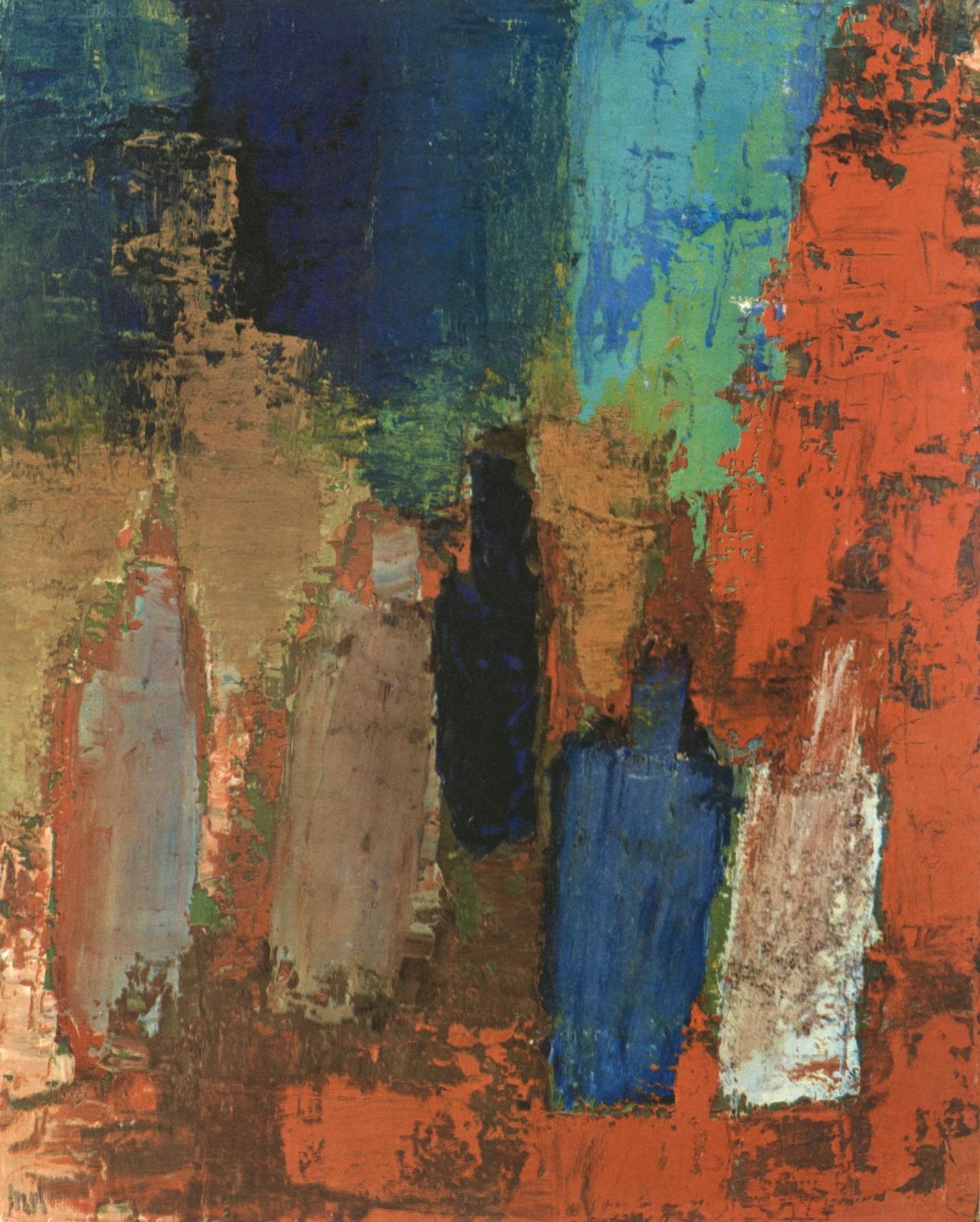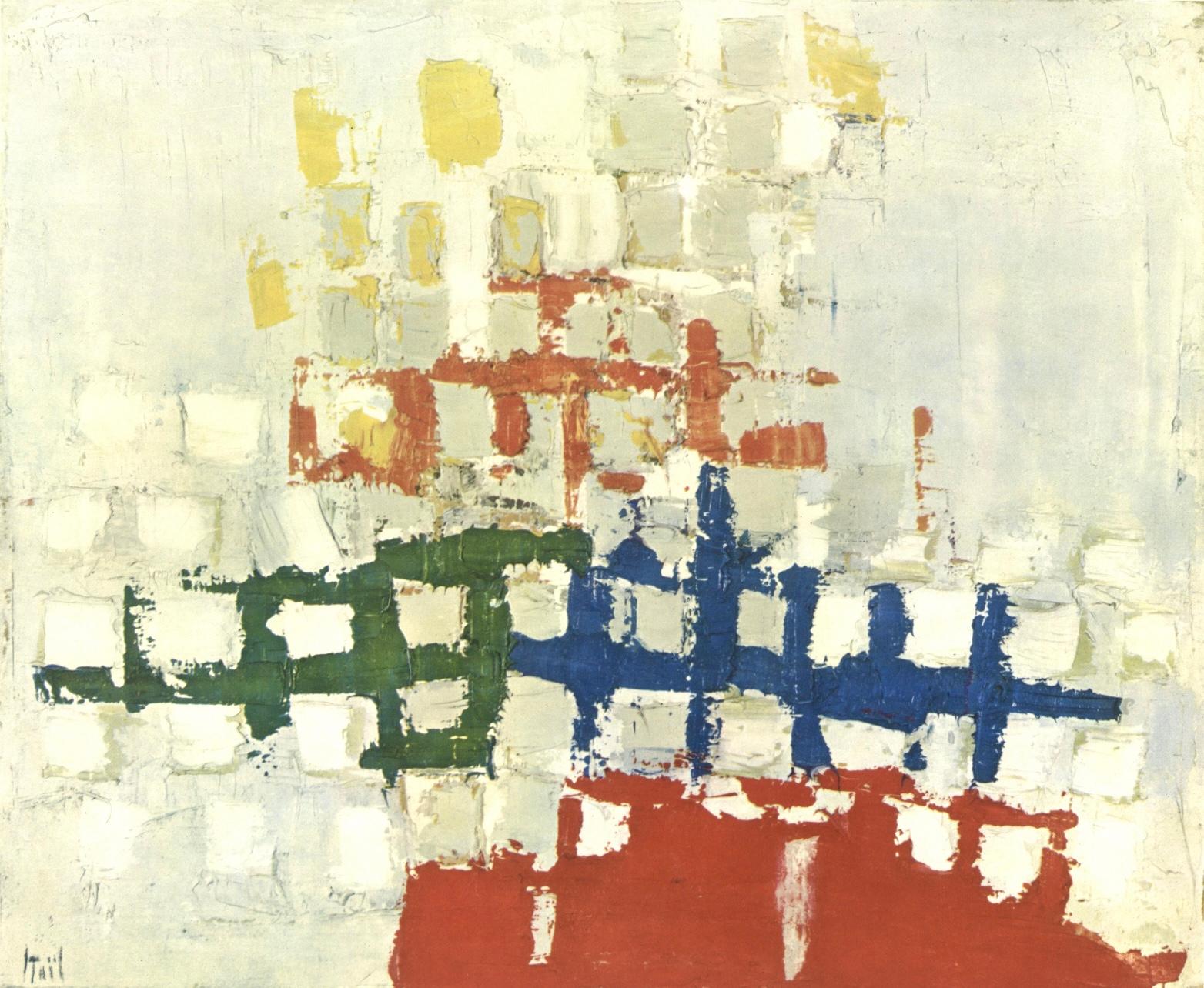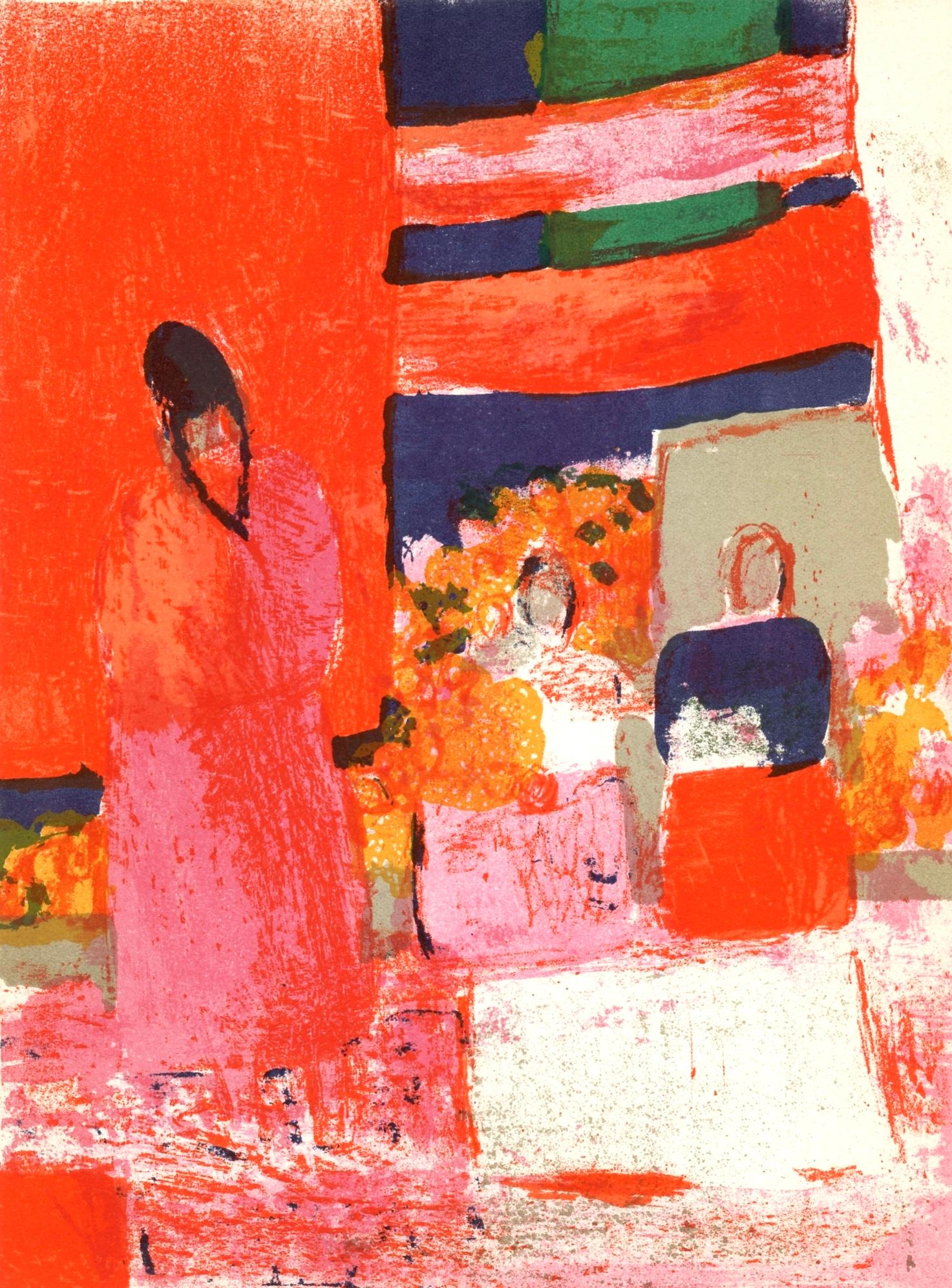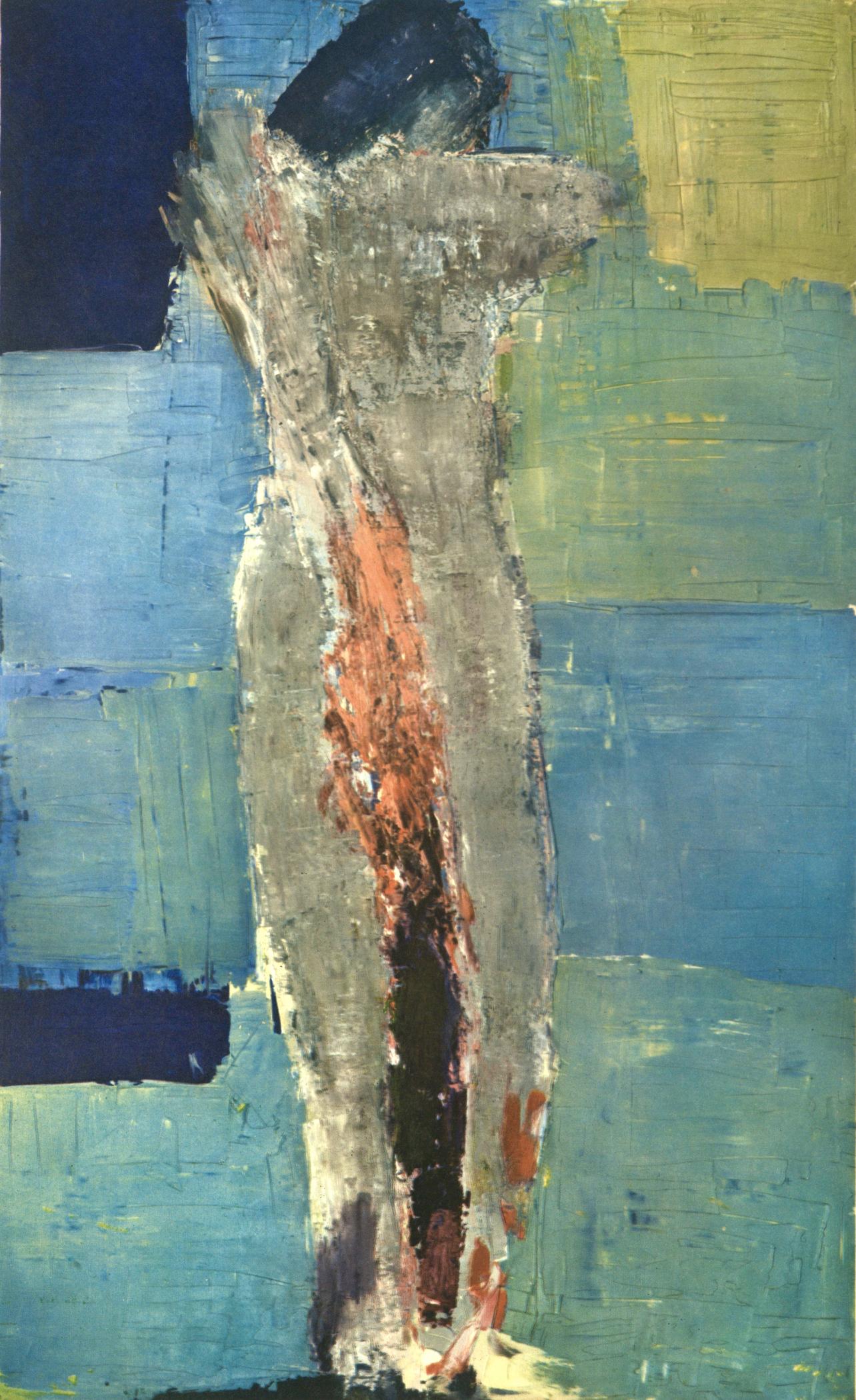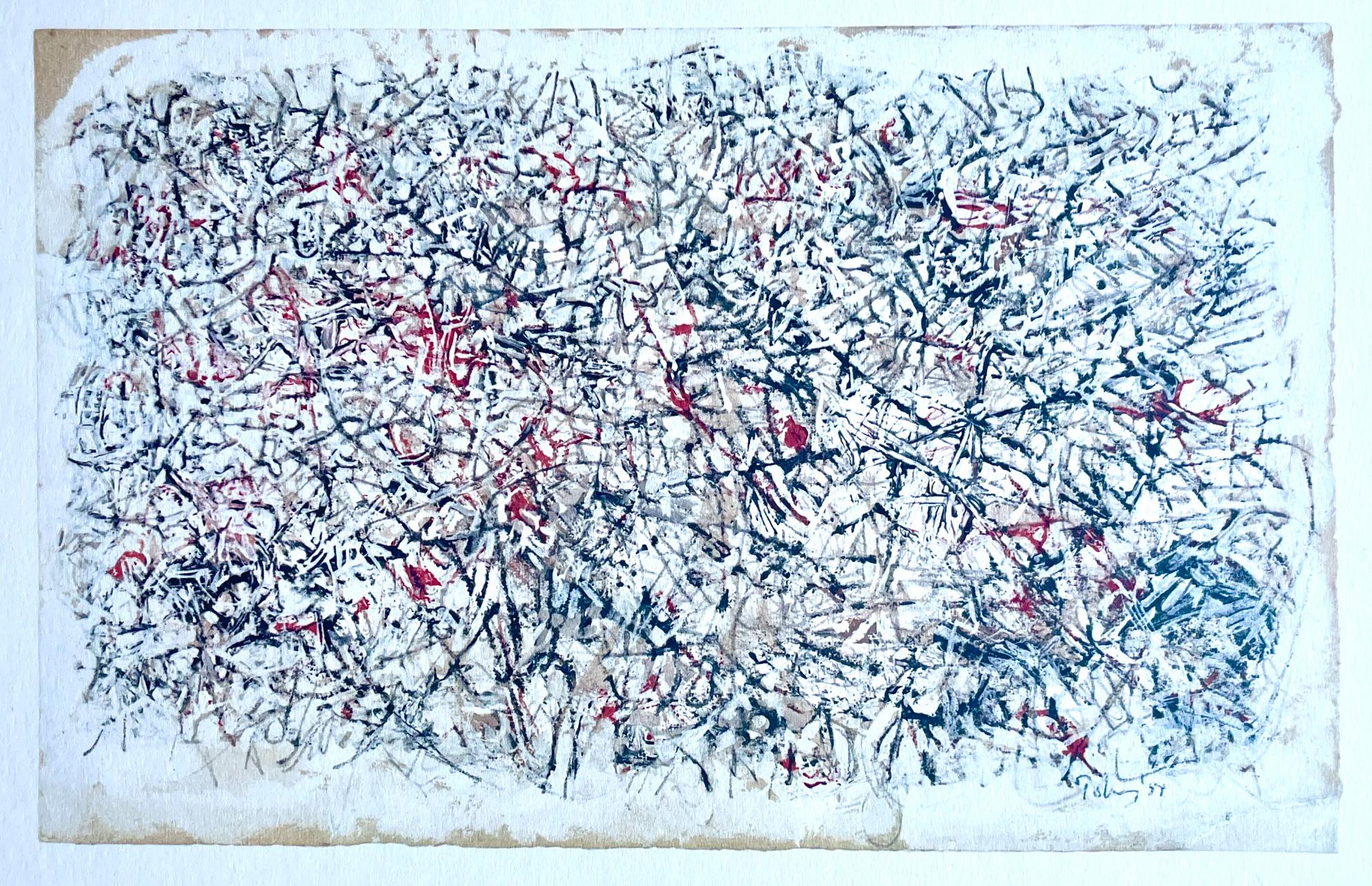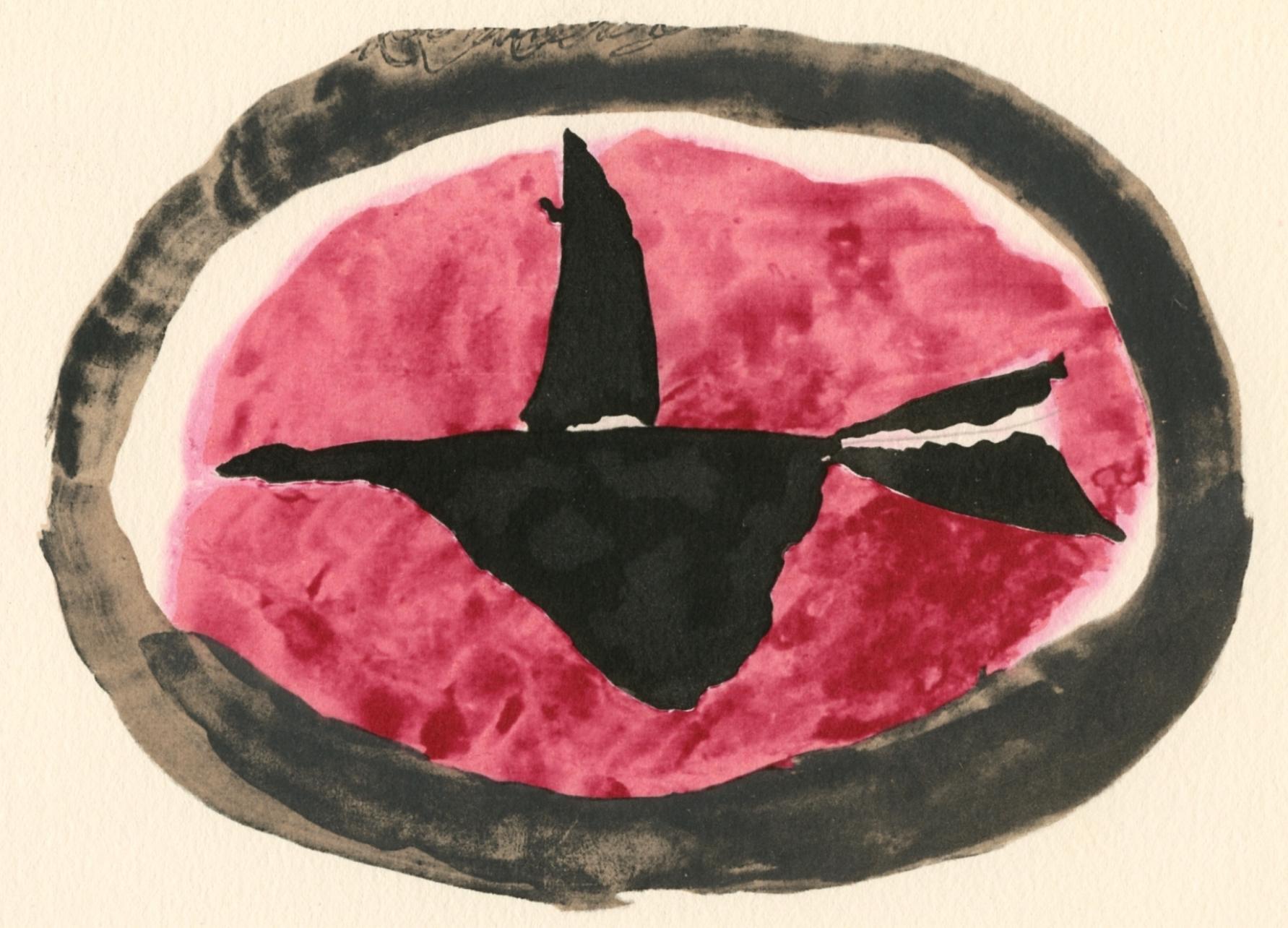Items Similar to Palazuelo, Composition, Derrière le miroir (after)
Want more images or videos?
Request additional images or videos from the seller
1 of 8
Palazuelo, Composition, Derrière le miroir (after)1952
1952
About the Item
Lithograph on wove paper. Inscription: Unsigned and unnumbered. Good condition with trifold, as issued. Notes: From Derrière le miroir, N° 50, published by Aimé Maeght, Éditeur, Paris; printed by Éditions Pierre à Feu, Galerie Maeght, Paris, October 1952. Excerpted from a Christie’s, New York lot essay, The life span of Derrière le Miroir was thirty-five years. Publication began in 1946. Aimé Maeght, initiator of Derrière le Miroir, had already made few attempts to start publications illustrated with fine printed lithographs in colours in the years prior to the launch of Derrière le Miroir. The name, Derrière le Miroir was suggested by Jacques Kober, manager of Galerie Maeght. The gallery had opened in 1945; the first number of Derrière le Miroir was released a year later. For this first issue Geer van Velde was invited to create lithographs to illustrate the publication. The lithographs in the first issue was printed by Mourlot, Paris. The first three issues of Derrière le Miroir were unsuccessful for Maeght as far as the edition size—the initial print-runs were far too large. From 30,000 for the first issue, the number was taken down to 10,000 for numbers two and three, until Derrière le Miroir number four was published in an edition of 1500. Maeght instituted a policy whereby unsold issues were recycled and used for the fabrication of new paper for the coming editions—this served to both conserve resources and also usually result in ultimate edition sizes far less than 1,500. With number four, the permanent format for Derrière le Miroir was established. Lithographs in colours were key; text was limited to comments on the featuring artist's exhibition taking place in the Galerie Maeght, and this catalogue format was defining to Derrière le Miroir. Galerie Maeght took on the leading role in Paris and presented all main artists including Braque, Matisse, Chagall, Léger, Bonnard, Chillida and many more. So too did Derrière le Miroir. The idea of a magazine was meanwhile still on the mind of Aimé Maeght. He found an insert as a solution. Two, and later four, pages of art review were inserted from 1952 onwards. In 1968 this find had ripened to independency and the dream of Aimé Maeght was now a tangible fact named l'Art vivant. Derrière le Miroir was on it's own again. Over 250 issues in a row. At that point publisher Aimé Maeght wished to make a mark with the publication of an hommage to all who once contributed to the magazine which came in the form of issue number 250, but was delayed by the death of Aimé Maeght. It was published after number 253 in 1982 and became a tribute to Aimé and Marguérite Maeght and 35 years of friendship with artists and poets. The era of Derrière le Miroir was closed with that final publication.
PABLO PALAZUELO (1915-2007) was born in Madrid. When he was just ten years old, a portrait painter created a pastel depicting him with his sister, making a great impression on him and instilling a strong interest in drawing and painting. Palazuelo began studying architecture in Madrid in 1932 and later at the School of Arts and Crafts, Oxford, England (1934–36). While there he became familiar with the Tecton group of architects (1932–48) and the work of artists such as Jacob Epstein and Duncan Grant. He took the Intermediate Exams of the Royal Institute of British Architects before the Spanish Civil War began in 1936, and he returned to serve as a pilot in the Spanish army. Palazuelo decided not to return to England and began to devote much time to painting, exhibiting at the Galería Buchholz, Madrid, in 1945 alongside members of the young Madrid School. In 1946 or 1947 he became enamored with Paul Klee’s work, specifically his interest in geometry and abstract geometric forms found in nature. Juan Gris, Pablo Picasso, and Daniel Vázquez Díaz, who was Palazuelo’s painting instructor in the late 1940s, also influenced his early abstracted still lifes. However, by 1948, Palazuelo had eliminated all figuration in his paintings, pursuing purely abstract forms. He exhibited his first abstract work in the inaugural Salon de Mai, Paris, in 1949. In 1948, aided by a French government grant, he had moved to Paris, where he would remain until 1969, coming into contact with artists associated with Galerie Maeght, where he had his first solo exhibition in 1955 and continued to exhibit until the 1980s. His 1950s work delved deeper into abstract form, as he explored Arabic and Eastern thought, particularly the musical rhythms of Islamic art, infinity, and the notion of the “active imagination.” In 1953–54, he participated in Younger European Painters: A Selection at the Guggenheim Museum. Between 1954, with his first sculpture in melted bronze, Ascendant, and 1962, he gradually began creating work in three dimensions, and in the 1970s working specifically with open and closed polygonal shapes. In 1969 he returned to Spain and settled in his family’s home close to San Lorenzo de El Escorial. He developed his foundational themes of inner conscience, imagination, and transmutation in public works such as Lauda II for Madrid’s Barajas Airport, and his mural for the foyer of the Picasso Tower, Madrid, in 1990. Palazuelo participated in the Pittsburgh International (now Carnegie International, 1955), as well as exhibitions at Galería Juana Mordó, Madrid (his first Spanish exhibition, 1964), and Musée des beaux-arts, Chaux-de-Fonds, Switzerland (1970). The Museo nacional centro de arte Reina Sofía, Madrid, presented a major retrospective of his work (1995) with a further expansion of the show a decade later. The most recent Palazuelo retrospective was co-organized by Museu d’art contemporani de Barcelona in conjunction with the Guggenheim Museum Bilbao (2005–06). He received numerous awards, including the Kandinsky Prize (1952); Carnegie Prize from Carnegie Museum of Art, Pittsburgh (1958); and the Medalla de Oro al Mérito en las Bellas Artes, awarded by the Spanish Ministry of Culture (1982). Palazuelo died on October 3, 2007.
- Creation Year:1952
- Dimensions:Height: 15 in (38.1 cm)Width: 33 in (83.82 cm)
- Medium:
- Movement & Style:
- After:Pablo Palazuelo (1915 - 2007)
- Period:
- Condition:
- Gallery Location:Auburn Hills, MI
- Reference Number:1stDibs: LU1465214321502
About the Seller
4.9
Gold Seller
These expertly vetted sellers are highly rated and consistently exceed customer expectations.
Established in 2002
1stDibs seller since 2021
867 sales on 1stDibs
Typical response time: 1 hour
- ShippingRetrieving quote...Ships From: Clinton Township, MI
- Return PolicyA return for this item may be initiated within 1 day of delivery.
Auctions on 1stDibs
Our timed auctions are an opportunity to bid on extraordinary design. We do not charge a Buyer's Premium and shipping is facilitated by 1stDibs and/or the seller. Plus, all auction purchases are covered by our comprehensive Buyer Protection. Learn More
More From This SellerView All
- Tobey, Recherche, Mark Tobey: Peintres d'aujourd'hui (after)By Mark TobeyLocated in Auburn Hills, MILithograph on wove paper. Unsigned and unnumbered, as issued. Good Condition; never framed or matted. Notes: From the folio, Mark Tobey: Peintres d'aujourd'hui, 1961. Published by Fe...Category
1960s Modern Abstract Prints
MaterialsLithograph
- de Staël, Composition, Nicolas de Staël: Peintres d'aujourd'hui (after)By Nicolas de StaëlLocated in Auburn Hills, MILithograph on wove paper. Unsigned and unnumbered, as issued. Good Condition; never framed or matted. Notes: From the folio, Nicolas de Staël: Peintres d'aujourd'hui, 1960. Published...Category
1960s Modern Abstract Prints
MaterialsLithograph
- Cathelin, Mexique, Prints from the Mourlot Press (after)By Bernard CathelinLocated in Auburn Hills, MILithograph on vélin d'Arches paper. Unsigned and unnumbered, as issued. Good Condition; never framed or matted. Notes: From the volume, Prints from the Mourlot Press, 1964. Publishe...Category
1960s Modern Abstract Prints
MaterialsLithograph
- Braque, Oiseau au couchant, Georges Braque le solitaire (after)By Georges BraqueLocated in Auburn Hills, MILithograph on Arches paper. Unsigned and unnumbered, as issued. Good Condition; never framed or matted. Notes: From the volume, Georges Braque le solitaire, 1959. Published by Editio...Category
1950s Modern Abstract Prints
MaterialsLithograph
- de Staël, Composition, Nicolas de Staël: Peintres d'aujourd'hui (after)By Nicolas de StaëlLocated in Auburn Hills, MILithograph on wove paper. Unsigned and unnumbered, as issued. Good Condition; never framed or matted. Notes: From the folio, Nicolas de Staël: Peintres d'aujourd'hui, 1960. Published...Category
1960s Modern Abstract Prints
MaterialsLithograph
- de Staël, Composition, Nicolas de Staël: Peintres d'aujourd'hui (after)By Nicolas de StaëlLocated in Auburn Hills, MILithograph on wove paper. Unsigned and unnumbered, as issued. Good Condition; never framed or matted. Notes: From the folio, Nicolas de Staël: Peintres d'aujourd'hui, 1960. Published...Category
1960s Modern Abstract Prints
MaterialsLithograph
You May Also Like
- (after) Antoine Pevsner - Face of a Man - LithographLocated in Collonge Bellerive, Geneve, CH(after) Antoine Pevsner - Face of a Man - Lithograph From the literary review "XXe Siècle" 1959 Signed in the plate Dimensions: 32 x 24 cm Publisher: ...Category
1950s Modern Abstract Prints
MaterialsLithograph
- Jacques Villon - Dance of the Universe - Original LithographBy Jacques VillonLocated in Collonge Bellerive, Geneve, CHJacques Villon - Dance of the Universe - Original Lithograph From the literary review "XXe Siècle" 1959 Dimensions: 32 x 24 cm Publisher: G. di San Lazzaro. Jacques Villon (1875 -...Category
1950s Modern Abstract Prints
MaterialsLithograph
- CarnivalBy Richard FlorsheimLocated in New York, NYRichard Florsheim created this color lithograph entitled “Carnival” in 1972 in an edition of 30 pieces. Published by Associated American Artists and printed by Landfall Press, this i...Category
1970s American Modern Abstract Prints
MaterialsLithograph
- Approaching StormBy Richard FlorsheimLocated in New York, NYRichard Florsheim created this color lithograph entitled “Approaching Storm” in 1967 in an edition of 125 pieces. Published by Associated American Artists and printed by Mourlot Press, Paris, this impression is signed and inscribed “Artist Proof.” It is in good condition with full original color. The printed image size is 28.25 x 19 3/4 inches and the paper size is 31.12 x 22 inches. RICHARD ABERLE...Category
1960s American Modern Landscape Prints
MaterialsLithograph
- Sky Swirl (Braniff International Airways), Alexander CalderBy Alexander CalderLocated in Fairfield, CTArtist: Alexander Calder (1898-1976) Title: Sky Swirl (from the Braniff International Airways Flying Colors Collection) Year: 1974 Medium: Lithograph on Arches paper Size: 20 x 26 i...Category
1970s Modern Abstract Prints
MaterialsLithograph
- Trees in Ranchitos II, New Mexico, 1970s Color Lithograph Landscape with TreesBy Andrew Michael DasburgLocated in Denver, CO"Tree in Ranchitos II" (New Mexico) is a lithograph initialed lower right by artist Andrew Michael Dasburg (1887-1979) from 1975. Presented in a custom frame measuring 30 ½ x 36 ¼ inches. Image size is 16 ½ x 23 ¼ inches. About the Artist: Born France, 1887 Died New Mexico, 1979 Andrew Dasburg was born in Paris, but emigrated to New York City in 1892 with his mother. A childhood sickness left him lame, and his artistic propensities were first recognized by a teacher at the crippled children’s school. She enrolled him in the Art Students League in 1902. There he studied under Kenyon Cox, Frank Vincent Dumond, and Birge Harrison. Later, he began taking night classes from Robert Henri at the New York School of Art. Dasburg spent 1908-1910 in Paris, where he was introduced to the great impressionist painters Matisse and Cezanne. Inspired by the work of the European modernists, Dasburg returned to the United States, where he moved to Woodstock, New York. In Woodstock, he and his wife, Grace Mott Johnson, lived with Morgan Russell...Category
1970s American Modern Landscape Prints
MaterialsLithograph, Archival Paper
Recently Viewed
View AllMore Ways To Browse
Le D De Dior
First Aid
Four Sisters
Vintage Islamic Art
Matisse 1948
Three Sisters Vintage
Too Young To Die
Retro Islamic Art
Swiss Army
Pablo Picasso Lithograph 1954
Pablo Picasso Lithograph 1949
Chagall 1955
Lithograph Sisters
Limited Edition Prints 1970s And 1980s
Portrait Of Marguerite
Jacob And Co
Arabic Limited Edition
Chagall Jacob
